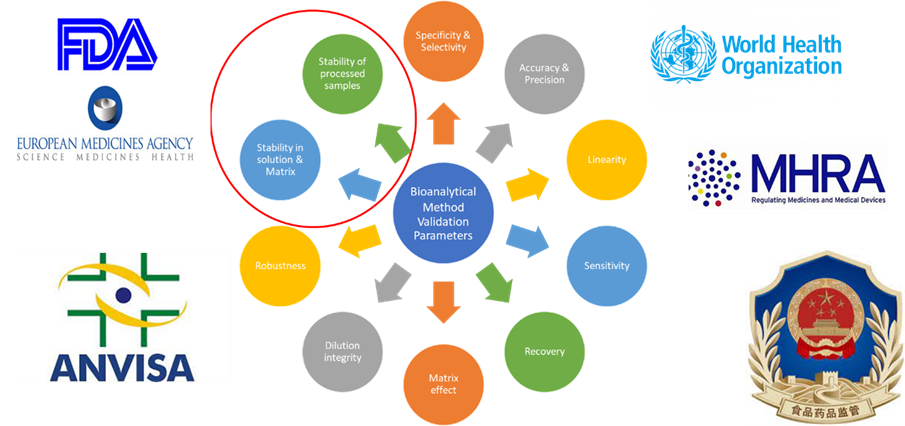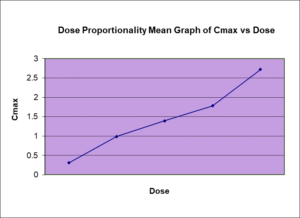Bioanalytical Method Validation Focus on Sample Stability

Bioanalytical method validation is performed to demonstrate that a given method is suitable for its intended use, i.e., in the quantitative analysis of drugs, metabolites and biomarkers in biological matrix (plasma, serum, urine, etc.). This is achieved by performing a series of experiments including: selectivity, sensitivity, accuracy and precision, linearity, recovery, matrix effect, and stability in solution and biological matrix.
The Importance of Sample Stability
Method validation is a regulatory requirement to support the integrity of quantitative bioanalytical data generated and submitted for regulatory fillings of pharmaceutical products in humans.
Inaccurate/unreliable results may lead to incorrect conclusions on the safety and efficacy of pharmaceutical products. Instability of the drug (analyte) can produce unreliable data if adequate procedures are not in place to preserve sample stability.
Thus, instability can occur at various stages of the bioanalysis process (sample collection, processing, storage, extraction and liquid chromatography mass spectrometry [LC-MS/MS] analysis). A demonstration of sample stability is therefore a critical component of bioanalytical method validation and is the theme of this scientific discussion.

Causes of Sample Instability
Many factors can impact the stability of an analyte of interest and/or its metabolite(s), including:
- Photochemical stability: Photochemical reactions are a common source of analyte instability in a biological matrix when the sample is exposed to ambient light.
- Thermal stability: Temperature is a critical factor to consider for sample processing, extraction, and long-term sample storage.
- Effects of pH: The pH of the sample in biological matrix or during extraction or analysis is one of the major factors that must be controlled if related to instability in samples.
- Effects of oxidation: Oxidation is another type of reaction that can lead to degradation of drugs in samples.
- Enzymatic degradation: Many drugs, such as those that contain an ester group, are susceptible to degradation from residual enzymatic activity that may still be present in biological matrix, post sample collection
- Hydrolysis of Conjugated Metabolites: Many ester-glucuronides are susceptible to ex vivo hydrolysis under alkaline or physiological conditions and/or in the presence of esterases.
- Chemical Reactivity: Compounds containing sulfhydryl groups (thiols) generally are unstable in biological matrices due to their chemical reactivity
- Inter-conversion/back-conversion: Some drug molecules can undergo inter-conversion during sample storage, thawing, extraction, sample extract drying, reconstitution and chromatography and/or mass spectrometry detection (in-source conversion).
BioPharma Services Case studies in dealing with unstable analytes in quantitative LC-MS/MS bioanalysis
Case Study 1. Determination of Trinitroglycerin, 1,2-Dinitroglycerin and 1,3-Dinitroglycerin in Human Plasma by LC-MS/MS.
Bioanalytical methods are required to be fully validated in the intended matrix and species (e.g., human plasma). Validation stability assessments in plasma include bench-top, freeze and thaw, and long-term frozen storage stability. The stability at collection, i.e., in whole blood, should also not be overlooked as ex-vivo degradation or instability in whole blood could lead to quantitative inaccuracy of data in plasma.
Trinitroglycerin is a medication indicated in the treatment of coronary artery disease. In vivo, it is metabolised to glycerol di-and mononitrate metabolites by a liver reductase enzyme. Extrahepatic metabolism in red blood cells has also been reported.
Here, for application in a bioequivalence study, a bioanalytical method for the measurement trinitroglycerin and its active metabolites in human plasma was required. Accordingly, a liquid chromatographic–mass spectrometric method was developed for the simultaneous determination of Trinitroglycerin and its metabolites, 1,2-Dinitroglycerin and 1,3-Dinitroglycerin in human plasma.
However, during pre-validation testing, the whole blood stability experiment repeatedly failed to meet acceptance criteria, and it was concluded that, consistent with its known extrahepatic metabolism in red blood cells, Trinitroglycerin rapidly degraded in whole blood to form its di- and mononitrate metabolites. Several approaches were investigated to develop a stabilization protocol.
Ultimately, the ex-vivo instability in whole blood was prevented by adding the enzyme inhibitor, iodoacetamide to whole blood immediately after collection. Under these conditions, the bioanalytical method was fully validated, and whole blood stability met validation acceptance criteria. The method was successfully applied to bioequivalence studies, allowing the accurate quantitation of Trinitroglycerin, and its metabolites. The applied validated assay also demonstrated >90% incurred sample reproducibility.
This case study describes an example of ex-vivo metabolism in whole blood that required the use of an enzyme inhibitor to preserve the stability of trinitroglycerin and metabolites in whole blood.
Case Study 2. Apomorphine in Human Plasma
Apomorphine is a derivative of morphine formed by acid-catalyzed rearrangement. It is a nonselective dopamine D1 and D2 receptor agonist, utilized as rescue medication in late-stage Parkinson’s disease. Apomorphine in solution undergoes rapid oxidation, producing a greenish colored solution. Dilute concentrations (50 ng/ml) of apomorphine in plasma are also unstable at 37°C and pH 7.4, where the half-life is less than 1 hour.
During the bioanalytical method development of quantitative validated assay for Apomorphine in human plasma, several antioxidant inhibitors were tested to stabilize Apomorphine in plasma. Results demonstrated that a combination of 2-Mercaptoethanol and Ascorbic Acid was required to stabilize plasma samples and prevent oxidative degradation. The final method used a Supported Liquid-Liquid Extraction. The calibration range was from 50.00 pg/mL to 15000.00 pg/mL. Samples are chromatographically separated on a C8 analytical column and the mass spectrometer (AB Sciex QTRAP 5500) is operated in positive ion mode using a turbo Ion spray source and MRM detection.
Under the optimized stability conditions, Apomorphine was stable in stock solution for least 16 days at -20°C, in plasma for 24 hours at 5°C and 82 days after long-term storage at -70°C and in extracted samples for 75 hours at 5°C. The bioanalytical method was successfully applied in pharmacokinetic studies to assess the bioequivalence of Apomorphine.
This case study describes an example of oxidative degradation that required the use of anti-oxidants to preserve the stability of Apomorphine in solution, plasma and in extracted samples.
Case Study 3. Bioanalytical Method development of determination Lenalidomide in human plasma by LC-MS/MS
Lenalidomide is a medication indicated in the treatment of conditions such as multiple myeloma. In vivo, Lenalidomide undergoes limited metabolism, and it is the major moiety in circulating plasma. Here, to support bioequivalence assessments of Lenalidomide formulations, there was a requirement for a validated assay in human plasma.
As a validated assay was successfully developed that utilizes a Protein Precipitation Extraction procedure requiring 50 μL of human plasma. Extracted samples are chromatographically separated on a biphenyl analytical column using a gradient elution. The mass spectrometer (AB Sciex API 4000) is operated in positive ion mode using a turbo Ion spray source and MRM detection. The total run time for a 10.0 μL injection is 4.5 minutes per sample.
In addition to the main bioanalytical method validation, an assessment of the long-term frozen storage stability was performed where it was found that there was about 20% degradation of Lenalidomide in plasma after 20 days of storage at −20C. This instability was not noticed during method development activities, as samples were handled for only 10 days.
Serial investigations were conducted, including a review of the literature, where non-enzymatic hydrolysis of lenalidomide (cleavage of the glutarimide ring) was reported in aqueous solution and plasma. Further testing showed that the major factor impacting the stability of Lenalidomide in plasma was the selection of the storage temperature. No significant loss of Lenalidomide in plasma was demonstrated for about two months when the storage temperature of samples was changed from -20C to -70C.
This case study describes an example of thermal degradation that required the use of lower storage temperatures to preserve the long-term storage temperature of Lenalidomide in plasma.
Summary
BioPharma Services takes great pride in the quality of its work to develop and validate robust bioanalytical methods that exhibit excellent performance when applied in clinical studies, with passing batches and ISR % of >98% achieved annually. Here, BioPharma Services described why sample stability is a fundamental bioanalytical method validation parameter that must be assessed and controlled to avoid inaccurate results in quantitative bioanalytical testing. Interested in seeing all our bioanalytical validated assays, click Here.
The exact cause for the instability can be different for bioanalytical applications. Understanding the nature of factors impacting sample stability is critical for developing an effective stabilization approach for rugged bioanalytical methods.
Written by Principal Research Scientist Hongzhi Liu in collaboration with Dr. Nicki Hughes.
Find out why BioPharma might be the right partner for you! Learn more about BioPharma Services and the wide array of bioanalytical services we provide.
BioPharma Services, Inc., a Think Research Corporation and clinical trial services company, is a full-service Contract Clinical Research Organization (CRO) based in Toronto, Canada, specializing in Phase 1 clinical trials 1/2a and Bioequivalence clinical trials for international pharmaceutical companies worldwide. BioPharma has clinical facilities both in the USA and Canada with access to healthy volunteers and special populations.



